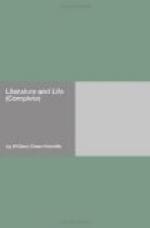“That might be all very well as far as furniture and carpets and curtains are concerned,” I said, “but surely you wouldn’t apply it to pictures and objects of art?”
“I would apply it to them first of all and above all,” rejoined my friend, hardily. “Among all the people who buy and own such things there is not one in a thousand who has any real taste or feeling for them, and the objects they choose are generally such as can only deprave and degrade them further. The pictures, statues, and vases supplied by the Standard Household-Effect Company would be selected by agents with a real sense of art, and a knowledge of it. When the house-letting and house-furnishing finally passed into the hands of the state, these things would be lent from the public galleries, or from immense municipal stores for the purpose.”
“And I suppose you would have ancestral portraits supplied along with the other pictures?” I sneered.
“Ancestral portraits, of course,” said my friend, with unruffled temper. “So few people have ancestors of their own that they will be very glad to have ancestral portraits chosen for them out of the collections of the company or the state. The agents of the one, or the officers of the other, will study the existing type of family face, and will select ancestors and ancestresses whose modelling, coloring, and expression agree with it, and will keep in view the race and nationality of the family whose ancestral portraits are to be supplied, so that there shall be no chance of the grossly improbable effect which ancestral portraits now have in many cases. Yes, I see no flaw in the scheme,” my friend concluded, “and no difficulty that can’t be easily overcome. We must alienate our household furniture, and make it so sensitively and exclusively the property of some impersonal agency—company or community, I don’t care which—that any care of it shall be a sort of crime; any sense of responsibility for its preservation a species of incivism punishable by fine or imprisonment. This, and nothing short of it, will be the salvation of the eternal-womanly.”
“And the perdition of something even more precious than that!”
“What can be more precious?”
“Individuality.”
“My dear friend,” demanded my visitor, who had risen, and whom I was gradually edging to the door, “do you mean to say there is any individuality in such things now? What have we been saying about character?”
“Ah, I see what you mean,” I said.




